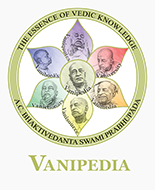 #div class="mw-parser-output"#
#h4##span class="mw-headline" id="TEXT_142"#TEXT 142#/span##/h4#
#div class="verse"#
#dl##dd#yā yā śrutir jalpati nirviśeṣaṁ#/dd#
#dd#sā sābhidhatte sa-viśeṣam eva#/dd#
#dd#vicāra-yoge sati hanta tāsāṁ#/dd#
#dd#prāyo balīyaḥ sa-viśeṣam eva#/dd##/dl#
#/div#
#h4##span class="mw-headline" id="SYNONYMS"#SYNONYMS#/span##/h4#
#div class="synonyms"#
yā yā — whatever; śrutiḥ — the Vedic hymns; jalpati — describe; nirviśeṣam — impersonal truth; sā — that; sā — that; abhidhatte — directly describes (like a dictionary meaning); sa-viśeṣam — personality; eva — certainly; vicāra-yoge — when accepted by intelligence; sati — being; hanta — alas; tāsām — of all the Vedic mantras; prāyaḥ — mostly; balīyaḥ — more powerful; sa-viśeṣam — personal variety; eva — certainly.
#/div#
#h4##span class="mw-headline" id="TRANSLATION"#TRANSLATION#/span##/h4#
#div class="translation"#
Śrī Caitanya Mahāprabhu continued, " 'Whatever Vedic mantras describe the Absolute Truth impersonally only prove in the end that the Absolute Truth is a person. The Supreme Lord is understood in two features-impersonal and personal. If one considers the Supreme Personality of Godhead in both features, he can actually understand the Absolute Truth. He knows that the personal understanding is stronger because we see that everything is full of variety. No one can see anything that is not full of variety.'
#/div#
#h4##span class="mw-headline" id="PURPORT"#PURPORT#/span##/h4#
#div class="purport"#
This is a quotation from the Śrī Caitanya-candrodaya-nāṭaka (6.67), by Kavi-karṇapura.
#/div#
#/div# #div class="mw-parser-output"#
#h4##span class="mw-headline" id="TEXT_142"#TEXT 142#/span##/h4#
#div class="verse"#
#dl##dd#yā yā śrutir jalpati nirviśeṣaṁ#/dd#
#dd#sā sābhidhatte sa-viśeṣam eva#/dd#
#dd#vicāra-yoge sati hanta tāsāṁ#/dd#
#dd#prāyo balīyaḥ sa-viśeṣam eva#/dd##/dl#
#/div#
#h4##span class="mw-headline" id="SYNONYMS"#SYNONYMS#/span##/h4#
#div class="synonyms"#
yā yā — whatever; śrutiḥ — the Vedic hymns; jalpati — describe; nirviśeṣam — impersonal truth; sā — that; sā — that; abhidhatte — directly describes (like a dictionary meaning); sa-viśeṣam — personality; eva — certainly; vicāra-yoge — when accepted by intelligence; sati — being; hanta — alas; tāsām — of all the Vedic mantras; prāyaḥ — mostly; balīyaḥ — more powerful; sa-viśeṣam — personal variety; eva — certainly.
#/div#
#h4##span class="mw-headline" id="TRANSLATION"#TRANSLATION#/span##/h4#
#div class="translation"#
Śrī Caitanya Mahāprabhu continued, " 'Whatever Vedic mantras describe the Absolute Truth impersonally only prove in the end that the Absolute Truth is a person. The Supreme Lord is understood in two features-impersonal and personal. If one considers the Supreme Personality of Godhead in both features, he can actually understand the Absolute Truth. He knows that the personal understanding is stronger because we see that everything is full of variety. No one can see anything that is not full of variety.'
#/div#
#h4##span class="mw-headline" id="PURPORT"#PURPORT#/span##/h4#
#div class="purport"#
This is a quotation from the Śrī Caitanya-candrodaya-nāṭaka (6.67), by Kavi-karṇapura.
#/div#
#/div# |
 #div class="mw-parser-output"#
#h4##span class="mw-headline" id="TEXT_142"#TEXT 142#/span##/h4#
#div class="verse"#
#dl##dd#yā yā śrutir jalpati nirviśeṣaṁ#/dd#
#dd#sā sābhidhatte sa-viśeṣam eva#/dd#
#dd#vicāra-yoge sati hanta tāsāṁ#/dd#
#dd#prāyo balīyaḥ sa-viśeṣam eva#/dd##/dl#
#/div#
#h4##span class="mw-headline" id="SYNONYMS"#SYNONYMS#/span##/h4#
#div class="synonyms"#
yā yā — whatever; śrutiḥ — the Vedic hymns; jalpati — describe; nirviśeṣam — impersonal truth; sā — that; sā — that; abhidhatte — directly describes (like a dictionary meaning); sa-viśeṣam — personality; eva — certainly; vicāra-yoge — when accepted by intelligence; sati — being; hanta — alas; tāsām — of all the Vedic mantras; prāyaḥ — mostly; balīyaḥ — more powerful; sa-viśeṣam — personal variety; eva — certainly.
#/div#
#h4##span class="mw-headline" id="TRANSLATION"#TRANSLATION#/span##/h4#
#div class="translation"#
Śrī Caitanya Mahāprabhu continued, “‘Whatever Vedic mantras describe the Absolute Truth impersonally only prove in the end that the Absolute Truth is a person. The Supreme Lord is understood in two features — impersonal and personal. If one considers the Supreme Personality of Godhead in both features, he can actually understand the Absolute Truth. He knows that the personal understanding is stronger because we see that everything is full of variety. No one can see anything that is not full of variety.’
#/div#
#h4##span class="mw-headline" id="PURPORT"#PURPORT#/span##/h4#
#div class="purport"#
This is a quotation from Śrī Caitanya-candrodaya-nāṭaka (6.67), by Kavi-karṇapūra.
#/div#
#/div# #div class="mw-parser-output"#
#h4##span class="mw-headline" id="TEXT_142"#TEXT 142#/span##/h4#
#div class="verse"#
#dl##dd#yā yā śrutir jalpati nirviśeṣaṁ#/dd#
#dd#sā sābhidhatte sa-viśeṣam eva#/dd#
#dd#vicāra-yoge sati hanta tāsāṁ#/dd#
#dd#prāyo balīyaḥ sa-viśeṣam eva#/dd##/dl#
#/div#
#h4##span class="mw-headline" id="SYNONYMS"#SYNONYMS#/span##/h4#
#div class="synonyms"#
yā yā — whatever; śrutiḥ — the Vedic hymns; jalpati — describe; nirviśeṣam — impersonal truth; sā — that; sā — that; abhidhatte — directly describes (like a dictionary meaning); sa-viśeṣam — personality; eva — certainly; vicāra-yoge — when accepted by intelligence; sati — being; hanta — alas; tāsām — of all the Vedic mantras; prāyaḥ — mostly; balīyaḥ — more powerful; sa-viśeṣam — personal variety; eva — certainly.
#/div#
#h4##span class="mw-headline" id="TRANSLATION"#TRANSLATION#/span##/h4#
#div class="translation"#
Śrī Caitanya Mahāprabhu continued, “‘Whatever Vedic mantras describe the Absolute Truth impersonally only prove in the end that the Absolute Truth is a person. The Supreme Lord is understood in two features — impersonal and personal. If one considers the Supreme Personality of Godhead in both features, he can actually understand the Absolute Truth. He knows that the personal understanding is stronger because we see that everything is full of variety. No one can see anything that is not full of variety.’
#/div#
#h4##span class="mw-headline" id="PURPORT"#PURPORT#/span##/h4#
#div class="purport"#
This is a quotation from Śrī Caitanya-candrodaya-nāṭaka (6.67), by Kavi-karṇapūra.
#/div#
#/div# |

 Compare previous verse
|
Compare next verse
Compare previous verse
|
Compare next verse 
